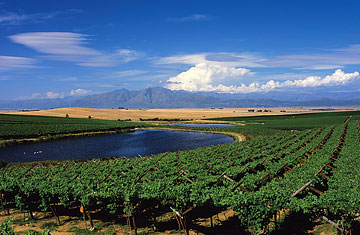
Seeds of revolt Vineyards planted at Riebeek Kasteel, in the heart of Swartland
To visit South Africa's famous winelands, you leave Cape Town and head for the mountains: south for Constantia, east for Stellenbosch and Franschhoek, northeast for Durbanville and Paarl. What's strange about that is that many of the grapes in South African wine are, in reality, grown in the hills a mere hour's drive north of the city. Swartland is Cape Town's back garden and a wine area of emerging importance, but it does not have the name and tourist appeal of the other winelands. Pretty as its old Dutch towns may be, they cannot compete with Franschhoek's blue mountains or the gabled estates and sea views of Constantia. And though some Swartland grapes are used in local wine, just as often they disappear into the blends of their grander cousins. "We're like the brother in jail that nobody talks about," says Callie Louw of Porcelain Mountain vineyards in southern Swartland.
Louw and four other winemakers — Eben Sadie, Adi Badenhorst and husband and wife Chris and Andrea Mullineux — want to change that. It helps that all are talented. Sadie, who moved to Swartland in 1997, is the current wunderkind of South African wine. The annual industry bible, Platter's South African Wines, made Sadie Family Wines this year's winery of the year and Sadie's Palladius blend white wine of the year. A.A. Badenhorst Family Wines' two blends (white and red) and dessert wine have likewise ranked among the country's best, while Mullineux Family Wines' first release, a dessert wine, was scored 96 out of 100 by legendary American critic Robert Parker, placing it among the very best wines ever, of any time or place. (Louw, who arrived only in 2009, will not release his first vintage until next year.)
Such success has encouraged the group to start the Swartland Revolution, recruiting support among winemakers who share their home and some rebellious ideas about wine. Grape varietal is one area in which they are setting up the barricades. South Africa's southern latitudes would place it between Sicily and Rome in the northern hemisphere. Yet most South African vineyards grow French grapes such as cabernet sauvignon or merlot (hence South Africa's bold, alcoholic reds), or sauvignon blanc or sémillon (source of its flinty, floral whites). The revolution demands a more geographically appropriate focus on Mediterranean varietals, such as shiraz, cinsault and grenache for reds, and chenin blanc and clairette blanche for white. "Every now and then, South Africa produces a great bordeaux wine," says Badenhorst. "But it's not what we should be doing. And if I drink another sauvignon-sémillon blend, I'll puke," he jokes.
Like many of history's great revolutions, Swartland's is also about land — or more specifically, terroir. "Historically, wine was a liquid fingerprint of the vineyard," says Sadie. "Now it's all shifted into the cellar and the ego of the winemaker." To reverse that, Swartland's rebels place a premium on old, unirrigated and untrellised vines and meticulous farming, using no pesticides or herbicides so as to maximize expression of local shales, clays and granites. They also emphasize whole-bunch pressing — squeezing entire bunches, stems and all, to lend the juice a tannic backbone — and relying on the grapes' own natural yeast for fermentation. Louw declares much modern winemaking to be "just a cover-up for bad farming," and plans his vineyards as self-sustaining biospheres of vines, wheat and livestock. Badenhorst has decided to emphasize his almost Luddite approach by naming his entry-level range Secateurs, after the vigneron's cutting tool. "We grow grapes," he says, "we pick them, we stomp them, we get wine." Long live the revolution.
